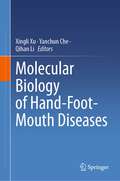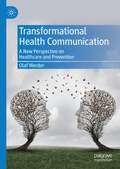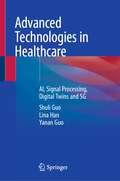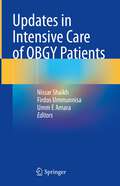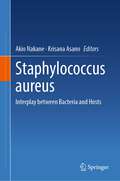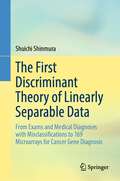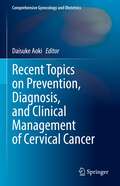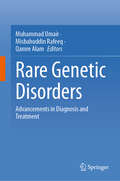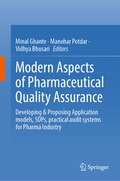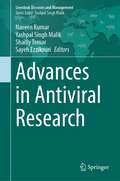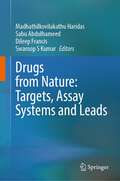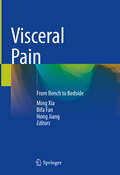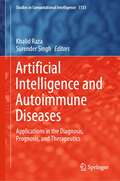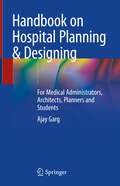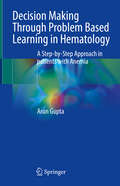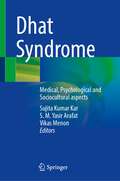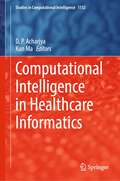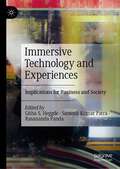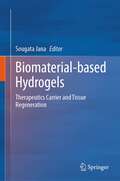- Table View
- List View
Molecular Biology of Hand-Foot-Mouth Diseases
by Xingli Xu Yanchun Che Qihan LiThis book aims to compile the latest scientific information on hand, foot, and mouth disease (HFMD), including its epidemiology, etiology, pathology, immune response and vaccine development. Interestingly, the authors shared their own research experience and offered distinctive insights into the pathogenesis of HFMD and vaccine development. The intended audience, including university researchers, graduate students, and vaccine engineers, is well defined. The book is positioned as a resource that not only presents current knowledge but also has the potential to inspire further research in understanding immune pathogenesis and advancing vaccine development for HFMD.
Transformational Health Communication: A New Perspective on Healthcare and Prevention
by Olaf WerderThis book advances our understanding of communicative relationships and key barriers to more effective health communication. In this, it offers a humanistic orientation of health communication as well as its social, cultural, political, ethical, and spiritual dimensions and contexts. The book therefore brings a more inclusive and integrated approach to the major challenges and opportunities in contemporary health, medicine, and wellbeing.
Advanced Technologies in Healthcare: AI, Signal Processing, Digital Twins and 5G
by Shuli Guo Lina Han Yanan GuoThis book explores the applications of cutting-edge technologies such as AI, blockchain, signal processing, digital twin technology, and 5G communication technology in healthcare. The writing style combines diagrams, tables, formulae, and text to enhance readability. The content combines theoretical analysis and medical application in every chapter. This book presents several innovative methods, including an AI-based computer-aided diagnosis system, a blockchain-based AI system framework for healthcare, pre-processing algorithms for medical imaging, digital twin models for healthcare, a healthcare platform based on cloud, fog, and edge computing, and a personal health device domain information model. This book will be valuable for researchers, engineers, and post-graduate students in the fields of medicine management and software engineering.
Updates in Intensive Care of OBGY Patients
by Nissar Shaikh Firdos Ummunnisa Umm E AmaraThis book presents the updated management of acute and critically ill obstetric and gynecological patients. It describes patients' care with pregnancy-induced medical disorders, comorbidities, and gynecological (OBGY) conditions requiring acute and intensive care support therapy. This book will guide early diagnosis and speedy management of life-threatening conditions. Chapters provide a comprehensive and systemic approach in an easy-to-understand format. Along with diseases and comorbidities of pregnancy, acute illness and its management caused by in vitro fertilization (IVF) are focused on, and a dedicated chapter about COVID-19 infection in obstetric patients is provided.Updates in Intensive Care of OBGY Patients will support intensivists, obstetricians, gynecologists, acute care physicians, and surgeons. Residents, fellows, specialists, and other junior medical staff working in intensive care units will also value this source. It will also help to broaden the understanding of nurses and paramedical staff in intensive care therapy.
Staphylococcus aureus: Interplay between Bacteria and Hosts
by Akio Nakane Krisana AsanoStaphylococcus aureus is an opportunistic human pathogen that colonizes the mucosal surfaces. It is the causative agent of various serious acute and chronic infections. Recent prevalence of infectious diseases caused and expanded by hospital-acquired methicillin-resistant S. aureus (HA-MRSA), community-acquired methicillin-resistant S. aureus (CA-MRSA) and livestock-acquired methicillin-resistant S. aureus (LA-MRSA). MRSA infections must be more serious problem in near future. It is presumed that offense and defense responses are continuously executed between S. aureus and host to establish and maintain commensalism for S. aureus. Therefore, it is essential to elucidate interplay between S. aureus and hosts to prevent staphylococcal infectious diseases. This book is comprised of content that focuses on this aspect.
The First Discriminant Theory of Linearly Separable Data: From Exams and Medical Diagnoses with Misclassifications to 169 Microarrays for Cancer Gene Diagnosis
by Shuichi ShinmuraThis book deals with the first discriminant theory of linearly separable data (LSD), Theory3, based on the four ordinary LSD of Theory1 and 169 microarrays (LSD) of Theory2. Furthermore, you can quickly analyze the medical data with the misclassified patients which is the true purpose of diagnoses. Author developed RIP (Optimal-linear discriminant function finding the combinatorial optimal solution) as Theory1 in decades ago, that found the minimum misclassifications. RIP discriminated 63 (=26−1) models of Swiss banknote (200*6) and found the minimum LSD: basic gene set (BGS). In Theory2, RIP discriminated Shipp microarray (77*7129) which was LSD and had only 32 nonzero coefficients (first Small Matryoshka; SM1). Because RIP discriminated another 7,097 genes and found SM2, the author developed the Matryoshka feature selection Method 2 (Program 3), that splits microarray into many SMs. Program4 can split microarray into many BGSs. Then, the wide columnLSD (Revolution-0), such as microarray (n Theory3 shows the surprising results of six ordinary data re-analyzed by Theory1 and Theory2 knowledge. Essence of Theory3 is described by using cephalopelvic disproportion (CPD) data. RIP discriminates CPD data (240*19) and finds two misclassifications unique for cesarean and natural-born groups. CPD238 omitting two patients becomes LSD, which is the first case selection method. Program4 finds BGS (14 vars.) the only variable selection method for Theory3. 32 (=25) models, including BGS, become LSD among (219−1) models. Because Program2 confirms BGS has the minimum average error rate, BGS is the most compact and best model satisfying Occam’s Razor. With this book, physicians obtain complete diagnostic results for disease, and engineers can become a true data scientist, by obtaining integral knowledge ofstatistics and mathematical programming with simple programs.
Recent Topics on Prevention, Diagnosis, and Clinical Management of Cervical Cancer (Comprehensive Gynecology and Obstetrics)
by Daisuke AokiThis book provides a practical overview of a central topic in cervical cancer concerning human papillomavirus (HPV), prevention, cervical cancer screening, diagnosis, and treatment. Since the finding of human papillomavirus (HPV) being the cause of cervical cancer and its precursor symptoms, effective screening based on HPV DNA testing and prevention methods by HPV vaccination are established. Furthermore, new surgical methods, radiation therapy, and drug therapy are developed. To summarize the history and the recent advancement, this book is presented in five attractive parts: pathogenesis and epidemiology, cancer screening and prevention strategies, diagnosis and clinical management of cervical intraepithelial neoplasia (CIN), surgical treatments, and multimodal therapy. Recent Topics on Prevention, Diagnosis, and Clinical Management of Cervical Cancer is an appealing source for gynecologists, gynecologic surgeons, gynecologic pathologists, and gynecologic, clinical, and radiation oncologists. Also, primary care doctors, public health nurses, nurses, and pharmacists involved in cancer and other medical personnel will find the information and challenges presented tempting.
Rare Genetic Disorders: Advancements in Diagnosis and Treatment
by Muhammad Umair Misbahuddin Rafeeq Qamre AlamThis book introduces different Rare Genetic Disorders (RGDs), and challenges in their diagnosis. The chapters of the book discuss the emerging research and clinical approaches for the diagnosis of rare genetic disorders. It further reviews the future of genetic therapies for the treatment of rare genetic diseases and examine the recent advancements in the field of genetic testing for the diagnosis of these diseases. The book also covers the role of variants in the genome (genetic modifiers) that alleviate (suppress) or exacerbate (enhance) the severity of the disease, resulting in the variability of phenotypic outcomes. Further, the book examines different animal models for critical understanding of disease mechanisms, and the opportunity to evaluate the effect of therapeutic compounds in pre-clinical studies. The subsequent chapters present the state-of-the-art drug discovery strategies and biological approaches for the treatment of rare genetic disorders. Towards the end, the book reviews the current challenges in the diagnosis and treatment of the patients of rare genetic disorders and future opportunities. This book is useful for clinical geneticists, molecular and biochemical geneticists, researchers working in gene therapy and genome editing.
Gastroenterology and Hepatology: Bench to Bedside
by Gourdas Choudhuri Anil C Anand P PiramanayagamThe book aims to be a handy compendium to the very voluminous texts of gastroenterology and hepatology existing in the knowledge market and provides the reader with an easy understanding of the bench knowledge (basic sciences) as they apply to bedside practice (clinical gastroenterology). With introduction and contributions from Prof Eamon Quigley, Former president of World Gastroenterology Organization and American College of Gastroenterology, the book covers the recent advances in the basic sciences that form an important pillar of the knowledge, thereby linking basic sciences such as anatomy, physiology, biochemistry, molecular medicine, etc. to clinical conditions, diseases and new therapeutic approaches in gastroenterology and hepatology. The book is written in a simple easy to read format, with a lot of diagrams and flowcharts, making it a handy guide. It also discusses in-depth about very common clinical conditions encountered in hospital settings such as ulcerative colitis, pseudomembranous colitis, colonic cancer, amebiasis, and various other syndromes and diseases. This book is a useful read for fellows and trainees in Gastroenterology and Hepatology, as well as gastroenterologists, hepatologists and physicians interested in digestive disorders.
Modern Aspects of Pharmaceutical Quality Assurance: Developing & Proposing Application models, SOPs, practical audit systems for Pharma Industry
by Minal Ghante Manohar Potdar Vidhya BhusariThe pharmaceutical quality system ensures that the process performance is suitably achieved, the product quality is regularly met, improved opportunities are identified and evaluated, and the knowledge is constantly expanded. Auditing also plays a crucial role within the pharmaceutical industry. It helps to assess and review quality to improve and build a better system for the benefit of companies. This book aims to develop a tool that will substantially decrease the number of Inspectional Observations and Warning letters, thus eliminating Import Alerts and Consent Decree. This book targets the Pharmaceutical Industry and students of Pharmaceutical Quality Assurance so they can get in hand-ready consolidated information on Pharmaceutical Quality guidelines, Quality metrics, and implementation of simplified SOP guidelines, plant layouts to implement Quality metrics for Pharmaceutical Manufacturing systems in tablets, capsules, liquid orals, and semi-solid dosage forms. The chapters cover the various aspects of Pharmaceutical Quality Assurance. The selection of topics is mainly based on the requirements of Pharmaceutical regulatory guidelines of India, the UK, the USA, Australia, and South Africa. Each chapter includes the abstract, detailed explanation, implementation guidelines, flowcharts, layouts, and Standard Operating Procedure of quality metrics for the Pharmaceutical Manufacturing System
Advances in Antiviral Research (Livestock Diseases and Management)
by Naveen Kumar Yashpal Singh Malik Shailly Tomar Sayeh EzzikouriThis book illustrates advancements in the sophisticated tools and techniques for discovering and designing new antiviral drugs, identifying approved drugs against new and emerging viruses through large-scale computational virtual screening or drug repurposing approaches, and their evaluation in various in vitro and in vivo models. The chapters also cover the challenges associated with the emergence of antiviral drug resistance and possible ways to counter them. It discusses bioinformatics tools and software and computational approaches for the discovery of antivirals. The books also outline approaches for designing broad-spectrum antivirals effective against viruses by epigenetic- and epitranscriptomic-targeted reprogramming. Further, it provides vital details on the procedures for drug applications, clinical trials, and their regulations. Finally, the book provides a comprehensive yet representative description of advances in antiviral research protocols and methodologies suitablefor antiviral researchers at all career stages, including graduate and postgraduate students and policy-makers.
Drugs from Nature: Targets, Assay Systems and Leads
by Madhathilkovilakathu Haridas Sabu Abdulhameed Dileep Francis Swaroop S KumarThis book provides an overview of the drug discovery process from natural sources such as plants and microbes. While technological advances have streamlined the drug discovery process, enhancing the throughput and success rates, the structural features of natural products remain the primary reference for small-molecule drug discovery. Focusing on the drug targets blocked/altered by natural/nature-inspired molecules, it covers how potential drug leads are screened and identified using appropriate assay systems, and the current status of drugs identified using such approaches. State-of-the-art approaches in target identification, assay development, and lead identification have also been discussed in detail. Other topics included are targets and leads in inflammation, cancer, reproductive medicine, cardiovascular and neuromuscular ailments, and infectious diseases as well as the challenges in translating drug leads into clinically viable drugs. This volume serves as a handbook for researchers in phytochemistry and drug discovery, and as a reference for researchers and students of applied biology.
Visceral Pain: From Bench to Bedside
by Hong Jiang Ming Xia Bifa FanPatients with chronic visceral pain present a challenge for medical providers because of their vague presenting symptoms and frequent lack of identifiable pathology. Despite this, chronic visceral pain can be a debilitating medical condition that increases morbidity and decreases quality of life; the long-term consequences of which cause significant socioeconomic burden and debility. Covering the newest trends, studies, diagnosis and treatments in visceral pain care, as well as the pain treatment strategies that have been successfully employed in the past, this book brings readers fully up to date with effective recognitions and treatments for visceral pain. The clinical evaluation and presentation of common chronic visceral pain conditions and multimodal treatment options that can be used to assist patients and providers are focused.
Rapid Review of ECG: Self-Assessment Questions, Case Studies and Clinical Correlation
by Tapas Kumar KoleyThis book makes for great reading and easy comprehension of ECG - at your pace! It is written mainly for students and family practitioners. The topics are covered using high-quality ECG tracings, summary boxes, and informative colored diagrams. The book starts with the fundamentals of electrocardiography and acquaints the reader with common electrocardiographs seen in coronary care units and also indoor and outdoor settings of hospitals. Divided into short 30 chapters, this book covers all the essential aspects, including electrophysiology, regular waves and complexes, electrical axis determination, and various abnormalities, including hypertrophy, myocardial ischemia, infarction, conduction disturbances, the effect of drugs and electrolytes, and cardiac arrhythmias. One can learn a topic in 12-15 minutes! The proposed book will empower readers and guide them through the challenges associated with learning the art of interpretation of ECGs ‐ providing readers the knowledge, the skills, and most importantly, the confidence necessary to make informed decisions, both at the examination hall as well as the bedside of the patient.
Artificial Intelligence and Autoimmune Diseases: Applications in the Diagnosis, Prognosis, and Therapeutics (Studies in Computational Intelligence #1133)
by Khalid Raza Surender SinghThe book provides an overview of various autoimmune disorders and how artificial intelligence (AI) and machine learning will be used for the diagnosis, prognosis, and treatment of these disorders. AI algorithms are used to create synthetic patient populations with the properties of actual patient cohorts, build personalized predictive models of drug combinations and unravel complex relationships between diet, microbiome, and genetic line-up to determine the comparative treatment response. The book highlights clinical applications and challenges of AI for the diagnosis and treatment/management of autoimmune disorders which includes Rheumatoid Arthritis (RA), Multiple Sclerosis (MS), Type I Diabetes, Psoriatic Arthritis (PsA), and other critical diseases.
Handbook on Hospital Planning & Designing: For Medical Administrators, Architects, Planners and Students
by Ajay GargThis handbook is in reference to the book "Manual of Hospital Planning and Designing" which was earlier published by Springer Nature.This "Handbook on Hospital Planning and Designing" is a helpful guide that shows how to build an efficient healthcare project. Carefully planning and designing hospitals is essential to deliver and effective healthcare facilities. It's basically a mix of art, science, and caring. This book highlights the rooms, spaces, MEP service, safety, security, equipment, instruments, and other support services.This book is a summary of the essentials for designers and planners who want to design hospitals. Architects, designers, doctors, and people who are involved in the designing of hospital, will find it useful. It helps them make places that work well, look nice, and care for patients best. Setting up the hospital project is more than just building. It's about creating places where people get better and feel good.This book explores everything about planning and designing hospitals in the given chapters from the beginning, covering all the departments until the hospital is all set up. This book is helpful for experienced architects with new ideas, a healthcare worker who wants the best for patients, or a student who loves learning about hospitals.
Pharmacovigilance Essentials: Advances, Challenges and Global Perspectives
by Mukesh Nandave Anoop KumarThe book explores the field of pharmacovigilance, its historical context, along with its critical role in ensuring the safety of medications across the world. From its foundational principles to cutting-edge advancements and future challenges, this book provides a thorough understanding of the field's intricacies. The book begins by establishing the fundamentals of pharmacovigilance, emphasizing its significance in monitoring, detecting, assessing, and preventing adverse drug reactions (ADRs) that occur during the use of medications. Delving into the history of pharmacovigilance and regulatory actions, the book traces the evolution of the field, highlighting significant milestones and the establishment of regulatory frameworks that govern medication safety. It explores the pivotal role of regulatory authorities in developing guidelines, regulations, and policies to safeguard public health. A significant aspect covered in the book is the processing of ADRs, providing insights into the steps involved in handling and evaluating ADR reports. The book also addresses specialized areas within pharmacovigilance, including vaccine safety surveillance, herbovigilance (monitoring the safety of herbal medicines), materiovigilance (monitoring the safety of medical devices), and hemovigilance (ensuring the safety of blood products). Additionally, the book explores the role of pharmacogenetics in pharmacovigilance, highlighting how genetic factors influence individual responses to medications and how this knowledge can be integrated into safety monitoring and risk assessment. This book also covers databases used in pharmacovigilance across the globe, aggregate reporting and pharmacovigilance systems in EU and non-EU countries, and the role of artificial intelligence.Finally, it emphasizes the need for continuous improvement, vigilance, and proactive measures to adapt to the changing healthcare landscape and address emerging safety concerns. The book serves as acomprehensive guide for healthcare professionals, researchers, regulators, and policymakers involved in pharmacovigilance.
Decision Making Through Problem Based Learning in Hematology: A Step-by-Step Approach in patients with Anemia
by Arun GuptaIn this era of teaching through problem-based learning, this unique book guides approaching patients with anemia through a step-by-step analysis of test results. It explains the rationale for requesting appropriate tests and analyzing them systematically and correlates each answer to the disease-based entity on the latest evidence. The target audience is undergraduate medical students during hematopathology training and the introductory phase in clinical Medicine and Hematology, postgraduate residents in Hematology and Medicine, and undergraduate and postgraduate Allied Health students. It provides a quick reference source for practitioners and teachers in medical and paramedical institutions. Question-answer format for quick review before exams. Hundreds of visual illustrations with microscopic images and tables.Quick reference for students in wards and clinics.
Veterinary Molecular Immunology
by Shijun J. ZhengThis book focuses primarily on the newly discovered theory and techniques of veterinary molecular immunology. It also covers application of modern immunological methods into the treatment and control of infectious diseases and cancer, and future research trends. In terms of new immunological theories, this book focuses on recently-discovered innate lymphocytes (ILCs), signal transduction triggered by engagement of pattern recognition receptors (PRRs) with pathogen-associated molecular patterns (PAMPs), and signal communication between nerve and immune systems, antimicrobial peptides, immunoregulation and checkpoint, development and maturation of T and B lymphocytes, regulatory T cells, immune tolerance, and immunosuppression and evasion. In terms of new techniques and application, the book covers the categories and designs of preventive and therapeutic vaccines and the principle of developing vaccination program, occurrence, development and immune evasion of cancer cells, and the novel techniques for cancer therapy. In addition, comparison of avian and porcine cytokines with human and mouse ones is also provided in the appendices to illustrate the differences in cytokines between species. This book is valuable for the undergraduates, graduate students or professional researchers with requirement for advanced studies in veterinary immunology. It meets their requirements for improving and expanding knowledge of immunology.
Translational Research in Pain and Itch
by Chao Ma Yuguang HuangThis book provides a comprehensive review of the latest advances in translational pain and itch research, and presents the cutting-edge developments in the study of our two principal, yet most mysteries sensations. Despite the slow progress in the discovery of effective therapies for chronic pain and pruritus, scientists around the globe now have a better understanding of why and how these conditions occur. Based on these findings, a series of novel treatment strategies are currently under development, and hopefully in a few years, medical practitioners will become more confident and optimistic when facing patients with these annoying and sometimes severe disorders. The contributing authors are world-renowned research scientists, who have made significant discoveries. The book is of interest to neuroscientists, neurologists and pharmacologists in both clinical and basic medical research field. In this second edition of the book, five existing chapters have been updated. Five new chapters have been added to reflect the lasted developments in the related field of research.
Medical Tourism in Developing Countries: A contemporary approach
by Bhupinder Chaudhary Dinesh Bhatia Mahesh Patel Sunaina Singh Sushman SharmaThis book provides a detailed insight into the amalgamation of the healthcare and hospitality sector, which brought forward the concept of healthcare tourism or medical tourism. There have not been comprehensive resources in this particular area. The available quality resources focus on the Western world. Countries like India are an upcoming and one of the most favored destinations for medical tourism, and this trend is going to increase exponentially in the coming years. This book is developed in a very simple and lucid manner to enable even a layman to grasp the key components of the healthcare and hospitality sector at different levels and gradually link it to the present scenario where factors like accreditation, health insurance, corporatization, and public policy make an impact. Scholars in these sectors attempt to provide the recent trends and prospects supported with updated information. Therefore, it can solve the problem of a single source of detailed information relevant to different yet interconnected industries with a focus on developing countries.
Dhat Syndrome: Medical, Psychological and Sociocultural aspects
by Sujita Kumar Kar S. M. Yasir Arafat Vikas MenonDhat Syndrome is known as a culture-bound syndrome in South Asia. People with Dhat Syndrome often present with anxiety and distress related to semen loss. Multiple somatic and sexual symptoms often accompany this. The symptoms of Dhat Syndrome closely resemble other neurotic and stress-related disorders. Myths related to sexuality are often the core phenomenon in dhat syndrome, which is responsible for the generation of psychopathology—addressing the myth's preliminary results in resolving psychopathology. However, many patients require pharmacological and psychological management. Due to strong cultural beliefs and associated myths, patients with Dhat Syndrome often reach out to traditional healers before getting the proper psychiatric consultation, further consolidating their myths and poor attitude toward treatment. However, Dhat Syndrome resembles a male entity; a similar entity is reported in females, where females attribute their non-pathological vaginal discharge to psychological distress. The pattern of symptoms has a significant resemblance with Dhat Syndrome in males. There is no standard book that exclusively discusses various aspects of Dhat Syndrome. This book examines the evolution of Dhat Syndrome to the current understanding of the disease and its management. Hence, this book will be unique and helpful for this disorder.
Computational Intelligence in Healthcare Informatics (Studies in Computational Intelligence #1132)
by D. P. Acharjya Kun MaThe book presents advancements in computational intelligence in perception with healthcare applications. Besides, the concepts, theory, and applications in various domains of healthcare systems including decision making in healthcare management, disease diagnosis, and electronic health records will be presented in a lucid manner. To achieve these objectives, both theoretical advances and its applications to healthcare problems will be stressed upon. This has been done to make the edited book more flexible and to stimulate further research interest in topics. The book is divided into four sections such as theoretical foundation of computational intelligence techniques, computational intelligence in analyzing health data, computational intelligence in electronic health record (EHR), and computational intelligence in ethical issues in health care.
Immersive Technology and Experiences: Implications for Business and Society
by Githa S. Heggde Santosh Kumar Patra Rasananda PandaThis book provides a comprehensive overview of the role of immersive technology with multiple sectoral perspectives, such as entertainment, education, health care, and more. It covers a detailed analysis of the latest trends and developments in the field. It encompasses practical insights on using immersive technology effectively through industry expert chapters, case studies, and real-world examples that demonstrate how immersive technology is being used in different industries. Chapters in this book are from academicians and industry professionals to create a fine balance of knowledge and practice perspective of today’s immersive technology. It is written in accessible language that is easy for non-experts to understand. It focuses on the future of immersive technology, exploring its potential impact on society and the economy. It provides insights into the challenges and opportunities that lie ahead and offers predictions on how immersive technology will continue to evolve in the years to come. It is a valuable resource for anyone learning more about immersive technology.
Biomaterial-based Hydrogels: Therapeutics Carrier and Tissue Regeneration
by Sougata JanaThis book highlights recent advances in natural and synthetic biomaterials-based hydrogel for drug delivery carriers and tissue engineering. It covers key topics such as chitosan, alginate, gelatin, cyclodextrin, cellulose, starch, hyaluronic acid, dextran, collagen hydrogel, Injectable hydrogel magnetic hydrogel, DNA-based hydrogels, 3D printing of hydrogels, hydrogel for bone tissue engineering and regenerative medicine, etc. Each chapter develops a particular aspect of recent advances in biomaterial-based Hydrogels delivery systems to cover the importance, fabrication technology, characterization, evaluation, delivery of therapeutic and biomedical applications, and future perspectives. Written by a group of renowned scientists, chemists, biologists, and engineers from around the world, the book is designed as an important reference resource for scientists and researchers working on advanced biomaterials in the fields of pharmaceuticals, biomedical science, biomedical engineering,nanotechnology, and material science for most updated findings and future research trends.
